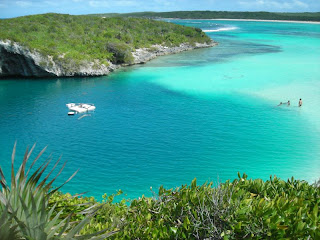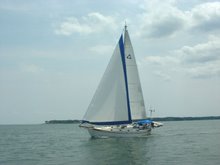Location: Thompson Bay, Long Island, Bahamas
Position: N23 21.619 W075 08.287
We haul anchor in Georgetown on Saturday, March 29th and have a lovely motorsail with the wind on the nose down to Thompson Bay, Long Island.
Some friends who rented a car ask us to accompany them on an exploration of Long Island south of our anchorage. They tell us to bring our snorkeling gear and a flashlight in case we find something interesting to investigate.
Position: N23 21.619 W075 08.287
We haul anchor in Georgetown on Saturday, March 29th and have a lovely motorsail with the wind on the nose down to Thompson Bay, Long Island.
Some friends who rented a car ask us to accompany them on an exploration of Long Island south of our anchorage. They tell us to bring our snorkeling gear and a flashlight in case we find something interesting to investigate.

We drive around following dirt roads trying to get lost and see what we can find and who we can meet. We were mainly in search of blue holes, coral to snorkel and caves, all of which are plentiful on this island, although almost never signposted, which makes discovery slightly more difficult and altogether interesting.
We follow some general directions, “Turn at the blue and white house” and finally see a couple of cars parked by a beach. We get out, walk to the beach and, tucked around the corner find a blue hole surrounded by craggy rock cliffs with a small raft in the middle and about 8 free divers in attendance. We start chatting with a fellow who’s watching them from shore.
He tells us that this is the deepest blue hole in the world at 660 feet, and the people on the raft are some of the world’s top athletes in the world of free diving. They’re practicing for a world championship competition being held right here, it’s scheduled for the 1st through the 11th of April. He is the head judge and expects two or three world records to be set during the competition. He tells us that Russia, Japan, Columbia, America, Italy, New Zealand, and several other nations are represented.
There’s some cloudiness in the water – it’s not the usual crystal clear water we’ve gotten used to in here the Bahamas. He tells us this presents a bit of a problem for the divers who train in the tropics. They’re not used to it being very dark ‘down there’ and, with the cloudiness it’s pretty dark at those depths. He’s hoping it will clear up in t
 he next few days in time for the competition.
he next few days in time for the competition.From Wikipedia: “Freediving is any of various aquatic activities that share the practice of breath-hold underwater diving. Examples include breathhold spearfishing, freedive photography, apnea competitions and, to a degree, snorkeling. The activity that garners the most public attention is competitive apnea, an extreme sport, in which competitors attempt to attain great depths, times or distances on a single breath without direct assistance of an underwater breathing apparatus.” Read more at: http://en.wikipedia.org/wiki/Free_diving
We don our snorkel gear and go for a swim. All four of us go around the perimeter of the blue hole and end up treading water about 8 feet from the platform watching the divers descend and ascend. A woman from Russia dives 51 meters with no fins! The current women’s world record is 56 meters deep (that’s 183.7 feet!!). Another Russian woman rides a weight down to 56 meters, sits there for a time, then swims back to the surface. We are amazed that a person could hold their breath for long enough to go that deep. One fellow from Columbia in fins acts as a spotter and, when the women go down, he follows them to make sure they are able to return without mishap. He does this multiple times and doesn’t seem at all winded when he returns to the surface.
We are struck by the cooperation we see between these divers. They’re all competing with each other for national and world records, yet they all chat and work together as friends.
After watching for a bit longer we go snorkel around for a time. When we get out of the water, the free divers are on shore shedding their wetsuits. Mark strikes up a conversation with ‘Natalie’ (the young, cute, bikini-clad one, of course!) and learns that she’s been free diving for 4 years. Her Russian compatriot, Natalia Molchanova has been doing it for 18 years and is apparently a real icon in the sport – she holds the women’s world record for holding her breath – for 8 minutes!! Mark asks her about the spirit of cooperation we noticed and she tells us that, even though they all do want to set a world record, they’re also all working toward doing their personal best and support and help each other to do so. She says “We don’t do it to set the records – we do it so we can be down there – there’s nothing like it in the world.”
We ask Natalie why she rode the weight down and swam back up. She tells us it’s known as a ‘variable dive’. She rode the weight down for practice so she could sit at world record depth and familiarize herself with the way this particular dive spot looks and feels at that depth. When she swam back to the surface she counted her strokes (it took 17) so she’d know how many she’d need in the competition. Riding the weight down allowed her to experience this without wearing herself out swimming down. She tells us that sitting at world record depth for a while was both educational and ‘fun’.
The Columbian ‘spotter’ tells us he has been free diving since he was 8 years old. We are surprised to learn that few of these world-class athletes have sponsors. We’re also struck by the fact that none of these people are big or barrel-chested. They are all slight, albeit with somewhat powerful shoulders and legs. Our Columbian friend tells us that he works on his technique in a pool 3 times a week and does very hard elliptical training for 20 minutes three times a week. Running, weights, and other heavy exercise are not part of his program.

We go back a few days later during to see some of the actual competition. Will Trubridge from New Zealand breaks the men’s “constant weight without fins” record with a dive to 84.5 meters (277.2 feet). We also make friends with another Will, a competitor from Canada, and he gives us an insider’s description of what’s taking place on the diving platform. Free divers are a friendly and accessible group of athletes.
Mark takes the opportunity to chat up Natalie again and asks her more about her background. It seems that she was a Russian national champion swimmer at 15 and was asked to join the Russian Olympic team. When she refused to participate in doping and taking performance enhancing drugs, she was labeled as “unreliable” and dropped. She decided that even though she loved athletics, there wasn’t much of a future in it for her. She decided to attend university and went on to get her Ph.D. in communications. Then she discovered free diving. She has since started her own business and teaches yoga and free diving.
To learn more about free diving and see the competition results, visit http://www.verticalblue.net and http://www.deeperblue.net. We’re disappointed to learn that our friend, Natalia Avseenko only made it down to 38 meters yesterday. We’ll check back later to see if she does better in a second attempt later in the competition.
Tomorrow we are leaving Thompson Bay. We haven’t yet decided whether we will head north and east to Conception Island or a bit west and farther south to the Jumentos. We’ll see what the whether reports look like in the morning and make our final decision. In either case, we plan to return to Georgetown for the Family Island Regatta on April 21st, then begin our trip back north toward our return to the US.
Stay Tuned!!






